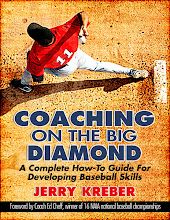Monday, November 13, 2006
Speeding Up Practice

Playing Continuous Defense in Threes
Objective:
To promote an up-tempo practice, incorporating all elements of defense and baserunning.
Procedure:
Stage I.
During the first defensive cycle, all outfielders will be stationed in right field. All infield positions will be played by defenders. Three different baserunning groups will be stationed at each base. The coach, standing at home plate, will begin the drill by hitting a ball to right field. The baserunner, stationed at second base, will try and score. The right fielder will throw to the plate, using the first baseman as the relay. The baserunner will try and avoid the tag, while the catcher tries to record the out. As the play finishes, the coach will roll a bunt to the next catcher, who should jump out right after the previous play. During the roll, the baserunner at first base will try and reach second base. The catcher and first baseman will converge to field the bunt. When the ball is fielded, the catcher or first baseman will try and record the out at first or second base. Immediately after that play finishes, the coach will hit an infield pop up. All infield players will communicate and record the out.
Stage II.
During the second defensive cycle, all outfielders will be stationed in centerfield. All infield positions will be played by defenders. Three different baserunning groups will be stationed at each base. The coach, standing at home plate, will begin the drill by hitting a ball to centerfield. The baserunner, stationed at first base, will try and advance to third base. The centerfielder will throw to third base, using the shortstop as the relay. The baserunner will try and avoid the tag, while the third baseman tries to record the out. As the play finishes, the coach will roll a bunt to the catcher, who should jump out right after the previous play. During the roll, the baserunner at second base will try and reach third base. The catcher and first baseman will converge to field the bunt. When the ball is fielded, the catcher or first baseman will try and record the out at first or third base. Moving on the play, the second baseman will cover first in case a throw is made to the base. Immediately after that play finishes, the coach will strike a shallow pop up to the centerfielder. Using the first baseman as the relay, the centerfield will fire home, trying to record the out.
Stage III.
During the third defensive cycle, all outfielders will be stationed in left fielder. All infield positions will be played by defenders. Three different baserunning groups will be stationed at each base. The coach, standing at home plate, will begin the drill by hitting a ball down the left field line. The baserunner, stationed at first base, will try and score. The left fielder, working with a tandem relay of shortstop and second base, will throw to the shortstop. The shortstop will try and keep the runner from scoring. As the play finishes, the coach will hit a groundball to the third baseman, who throw the ball to first base. After the out, the coach will hit a final ball to the second baseman will turn a double play with the shortstop and first baseman.
Summary:
Today, many players find baseball's playing tempo very slow. To hold their attention, coaches must look for ways to enhance practice tempo. Incorporating drills with more than one ball, challenge players to stay involved with a play and not lose concentration. Also, it helps to make practice fun and exciting. If players get some enjoyment out of practice, they will continue to find joy in the sport.
